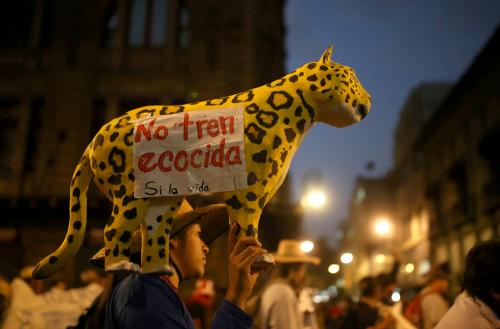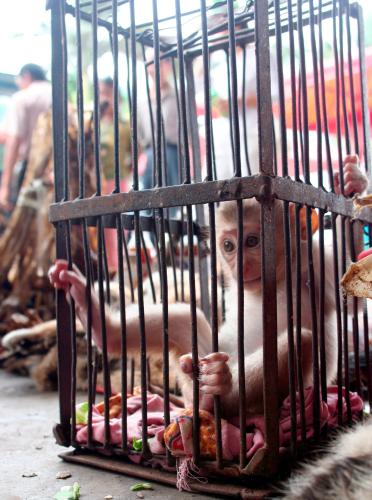The effects of COVID-19 underscore the need for measures to minimize the chances of another zoonotic pandemic, writes Vanda Felbab-Brown. That means changing how humans interact with wildlife and natural habitats, preserving terrestrial ecosystems and biodiversity, and overhauling food production. This piece was originally published by Project Syndicate, as part of its On Point, Special Edition Magazine, Fall 2020: The Green Recovery.
The devastation wrought by COVID-19 underscores the need for measures to minimize the chances of another zoonotic pandemic. That means radically changing how humans interact with wildlife and natural habitats, preserving terrestrial ecosystems and biodiversity, and overhauling food production. Otherwise, another contagion originating from animals could arrive at any time, compounding the disastrous legacy of COVID-19. Worse, this would feed into a vicious cycle: less money for conservation would lead to even more pressure placed on natural habitats, more human-wildlife contact, and a greater chance of more outbreaks.
Spreading out of a food market in Wuhan, China, the COVID-19 pandemic emerged as the predictable result of trade or trafficking in wild-animal meat. China’s epidemic of severe acute respiratory syndrome (SARS) in 2003 started the same way. Across East and Southeast Asia, markets selling meat from wild and illegally caught animals – most kept in appalling and dangerously unhygienic conditions – are literal breeding grounds for zoogenic pandemics.
But pandemics can also result from improper husbandry, when domestic livestock are not separated from wild animals, as well as from veterinary failures. These outcomes tend to follow from regulatory deficiencies, which are pervasive around the world, including in the United States. The H1N1 “swine flu” that killed 10,000 people in the United States in 2009 emerged from North American pig herds.
Like wildlife markets, these food production systems are breeding grounds for infectious disease. Packing thousands of domestic livestock together in a cramped space significantly accelerates the spread of zoogenic pathogens, thus amplifying the rate of viral mutations and the chances of a spillover into humans.
A final major source of zoonotic diseases is habitat destruction from logging, mining, and agriculture. All of these practices force many taxa of animals closer together, facilitating viral transmission and mutations.
The combined effects of these factors have dramatically increased the frequency with which zoonotic diseases are emerging, and their underappreciated costs are now coming due. The economic destruction and human dislocation caused by COVID-19 have already surpassed what one sees in a major regional war. In early June 2020, the World Bank warned that the pandemic would push 71-100 million people into extreme poverty. That may well be an underestimate. Around the world, many of those affected by the illness, lockdowns, and economic collapse have depleted their existing assets and are deprived of health care, food, schooling, and other means of human capital development.
The social strife and political instability arising from such conditions has already led to authoritarian power grabs in some parts of the world, and will continue to command policymakers’ attention. Although cash transfers and other emergency policies can help to offset some of the worst effects on businesses and households, attention must not be diverted from longer-term priorities, such as strengthening health systems and reshaping global value chains and logistics. There is every reason to worry that measures to detect and prevent the spread of new zoonotic outbreaks will be among the first triage casualties.
Reducing the likelihood of another zoonotic pandemic requires eliminating transmission points where there is a high likelihood of viral spillovers, such as unhygienic commercial wildlife markets. Beyond that, governments must be more diligent about suppressing the illegal and unsustainable trade in wildlife and conserving natural habitats.
Meaningful conservation, in turn, will require profound changes in how we produce our food and engage with nature more generally. Properly sequenced bans on wildlife markets – particularly in urban parts of Asia, Africa, and Latin America, where people do not depend on wild-animal meat for sustenance – should be accompanied by sustained enforcement, as well as by measures such as public-messaging campaigns, to reduce demand for wild-animal meat. And in cases where proper hygienic conditions can be deployed to ensure that meat is free of diseases, exceptions can then be issued for certain types of wild-animal meat. Consumption of ungulates, for example, can actually support the preservation of native habitats.
Equally crucial is enforcement to prevent poaching and wildlife trafficking, as well as the provision of alternative livelihoods for potential poachers and smugglers. Beyond wild meat, the demand for other wildlife products, such as those used in traditional Chinese medicine, must be curtailed. And when it comes to the massive transnational legal trade in wildlife, the system would benefit from much more monitoring than exists today.
But that doesn’t mean automatically banning all trade in wildlife or trophy hunting. When properly managed, these activities can create economic incentives for preserving critical natural ecosystems. By the same token, preventing the next pandemic should not entail eliminating the livelihoods of the hundreds of millions of people who depend on hunting for food security and subsistence. Even with programs to provide alternative sources of protein, many communities will consume wild-animal meat. In these cases, rather than attempting to ban the practice outright, policymakers should focus on improving access to medical and veterinary services to inspect dead wild animals and track cases of people getting sick after handling animals or corpses.
Though it is equally important to reduce destructive logging and agricultural practices, the economic fallout from COVID-19 has actually exacerbated these problems, along with poaching. Economic immiseration has driven the poor from urban spaces to rural areas, and empowered extractive industries. Many governments, desperate for any source of additional revenue and employment, are understandably focused on the short term. Yet when it comes to preventing another catastrophe, the need for commonsense measures against future zoonotic outbreaks could not be more urgent.









Commentary
Preventing the next zoonotic pandemic
October 6, 2020